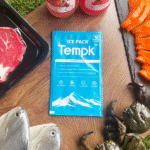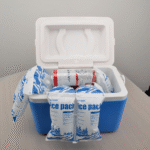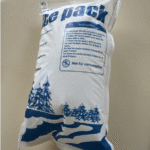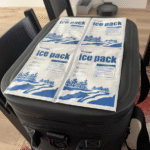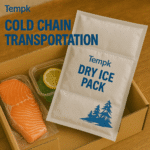How to Use a Dry Ice Pack for Shipping Food (2025)
If you use a dry ice pack for shipping food the right way, your products stay frozen, patuh, and safe. Yang pertama 50 words you’ll learn how to size dry ice, pack boxes, and label correctly. Expect clear steps, quick rules of thumb, Dan 2025 updates so you can ship with confidence and reduce waste.

-
How a dry ice pack for shipping food works and when to use it
-
Persis bagaimana cara mengemas, lubang angin, and place dry ice for best results
-
How much dry ice you need by box size, rute, and climate
-
Label apa, batas, and safety steps keep you compliant
-
2025 tren: greener CO₂, ultra‑cold PCMs, and smart packaging
This article merges the strengths of your three drafts into one updated guide.
Apa itu dry ice pack for shipping food—and when should you use it?
A dry ice pack for shipping food keeps contents below freezing by sublimating at –78.5 °C, giving long, dry cooling with no meltwater. It is ideal for frozen meats, hidangan laut, pastry, and ice cream on 24–72‑hour routes. Plan roughly 5–10lb (2.3–4.5kg) per 24 jam per midsize insulated shipper.
Use it when the product must arrive frozen, not just chilled. Avoid dry ice for items that must not membekukan (MISALNYA., fresh berries at 2–8 °C); choose gel packs instead. You’ll get cleaner boxes, lebih sedikit kebocoran, and longer hold times than with wet ice.
Dry ice pack vs. gel packs for shipping food
Key differences in real shipments—what you’ll notice on delivery.
| Pendingin | Practical range | Typical hold time* | Apa artinya ini bagi Anda |
|---|---|---|---|
| Dry ice pack for shipping food | ~–78.5 °C vapor blanket | 24–72+ hours | Arrives rock‑solid; tidak ada air. Requires venting and gloves. |
| Gel Ice Packs | 0 °C to –18 °C | 12–48 hours | Great for 2–8 °C foods; won’t keep items frozen on long routes. |
| Wet ice | 0 ° C. | 6–24 jam | Cheap, but soggy boxes and short life. |
*Hold time varies with insulation thickness, load mass, and ambient heat.
Practical tips you can apply today
-
Ship early in the week. Avoid weekend stranding that outlasts your dry ice.
-
Pre‑freeze the load. Dry ice maintains frozen state; it’s not a fast freezer.
-
Tempatkan es kering di atas. Wastafel dingin; top placement gives better coverage.
Kasus nyata: A bakery shipping ice‑cream cakes added 14 lb of dry ice to a 2‑inch EPS box for a two‑day route. Cakes arrived rock‑solid even after a 10‑hour hub delay thanks to top‑loading and vented lid.
How do you pack a dry ice pack for shipping food step‑by‑step?
Core setup that works across carriers and lanes.
-
Choose the shipper. Use a tight‑fitting EPS or VIP insert inside a strong corrugated box.
-
Prasyarat. Freeze products to target temperature before packing.
-
Wrap & separate. Bag food items; tambahkan penghalang (cardboard tray) between product and dry ice.
-
Add dry ice packs. With gloves, tempat di atas (and optionally around sides) for vapor coverage.
-
Ventilasi wadahnya. Never airtight‑seal; allow CO₂ to escape.
-
Isi kekosongan. Use paper or pads to prevent shifting and thermal leaks.
-
Menutup, tape, dan label. Add required marks and net dry‑ice weight.
Venting and placement best practices (Jangan lewati)
-
Leave a small lid gap or use vented lids. This prevents pressure buildup.
-
Hindari kontak langsung. A thin spacer protects delicate foods from surface freeze‑cracking.
-
Double‑box heavy loads. Dry ice can embrittle thin plastics; use sturdy outers.
| Packing layer | Mengapa itu penting | What to use | Impact for you |
|---|---|---|---|
| Kotak luar | Stack strength | 44‑ECT corrugated | Fewer crush damages |
| Isolasi | Heat barrier | 1.5–2″ EPS or VIP | Longer hold times |
| Spacer | No product contact | Cardboard/bubble | Prevents freeze‑burn |
| Dry ice pack for shipping food | Cold source | Slabs or pellets in paper | Even vapor, cleaner handling |
How much dry ice pack for shipping food do you need?
Aturan cepat: Mulai 8 lb per 24 h per cubic foot of insulated space, then adjust for route and weather. Hot lanes or thin insulation need more. Always round up for delays.
Fast estimator (copy‑paste logic)
Thumb‑table for common boxes
| Box (batin) | Route | Climate | Dry ice pack for shipping food (recommended) |
|---|---|---|---|
| 10″×10″×10″ (~0.6 ft³) | 24 H | Sedang | 6–7 lb |
| 12″×12″×12″ (~1.0 ft³) | 48 H | Panas | 12–14 lb |
| 14″×14″×14″ (~1.6 ft³) | 72 H | Sedang | 20–24 lb |
Pro tip: Split dry ice into several small packs instead of one large block for more even vapor.
Dry ice pack for shipping food: peraturan, Label, dan keamanan
Compliance checklist you can print:
-
Nama yang tepat & Dan: “Karbon dioksida, padat (Es kering), Dan1845.”
-
Hazard class: Kelas 9 (Miscellaneous).
-
Tanda: Show net dry‑ice weight (kg) on one vertical side.
-
Ventilasi: Kemasan harus allow CO₂ to escape.
-
Dokumentasi: Follow your carrier’s dry‑ice declaration steps for air.
-
Pelatihan: Staff preparing udara dry‑ice shipments should be HazMat/DG‑trained.
Recipient safety note: Include a slip: “Open in a ventilated area; do not touch dry ice with bare hands; let remaining dry ice evaporate outdoors.”
Receiving, penyimpanan, and disposal—what should your team do?
-
On arrival: Move the box to a ventilated space. Don’t store in a sealed room or vehicle.
-
Penanganan: Use insulated gloves; avoid metal surfaces that can frost‑bond to skin.
-
Pembuangan: Let any leftover dry ice evaporate away from people and pets. Never bin, sink, or drain.
2025 Perkembangan dan tren rantai dingin
What’s new this year—and how it affects a dry ice pack for shipping food.
More shippers are switching to CO₂‑recaptured “green” dry ice, ultra‑cold reusable PCM packs (–70 °C class), Dan sensor‑enabled shippers that track temperature and CO₂ levels in real time. These upgrades reduce scope‑3 emissions, improve lane reliability, and boost customer confidence.
Kemajuan terbaru sekilas
-
Green CO₂ sourcing: Lower‑impact dry ice from captured emissions.
-
–70 °C PCM blocks: Reusable alternatives for select lanes and returns.
-
Smart vents & CO₂ alerts: Prevent over‑pressurization and enable proactive handling.
Wawasan pasar: Demand for frozen e‑commerce foods and biologics continues to rise, pushing longer lanes and hotter last‑mile conditions. Expect higher adoption of thicker insulation (VIP) and hybrid coolant strategies to reduce total dry‑ice mass while preserving outcomes.
FAQ
Q1: Can I put a dry ice pack for shipping food in a regular cooler?
Ya, Tetapi vent the lid. Co₂ harus melarikan diri. Most plastic coolers are fine for short routes, though very thin walls shorten hold time.
Q2: How do I prevent freezer‑burn or cracking?
Insert a spacer (cardboard tray) so dry ice doesn’t directly touch delicate foods. Bag products to avoid desiccation.
Q3: What if the route extends unexpectedly?
Pack a 15–25% buffer of dry ice and ship early in the week. Consider a 2‑day service upgrade on hot lanes.
Q4: Is a dry ice pack for shipping food safe in cars or vans?
Transport with windows slightly open. CO₂ can build up in confined vehicles.
Q5: Do I need special labels for ground shipments?
You must still mark “Dry Ice, Dan1845 " Dan Berat bersih and use vented packaging. Air has stricter rules.
Q6: When should I choose gel packs instead?
If the target is 2–8 ° C., gel packs beat dry ice. They won’t freeze produce or chocolate.
Ringkasan & Rekomendasi
What matters most: Gunakan a dry ice pack for shipping food when you must arrive frozen; pre‑freeze loads; place dry ice di atas; keep packaging ventilasi; tanda Dan1845 + Kg net; and pack 15% extra untuk penundaan. These basics prevent thaw, kebocoran, and compliance issues.
Langkah selanjutnya:
-
Map your longest lane and size dry ice with the estimator.
-
Upgrade to 2″ insulation on summer routes.
-
Standardize labels and receiver instructions.
-
Pilot a smart‑sensor shipper on your highest‑risk lane.
CTA: Need a lane‑by‑lane dry‑ice plan? Talk to Tempk’s cold‑chain team today.
Tentang tempk
We’re specialists in temperature‑controlled packaging. Our portfolio spans dry ice pack for shipping food solusi, high‑performance gel packs, and pre‑qualified shippers that hold 2–8 °C for 72 h or frozen ranges for multiple days. We combine materials science with lane modeling to cut spoilage and cost. Two things clients tell us they value most: predictable hold times Dan jernih, simple SOPs.
Let’s build your SOP: We’ll size dry ice for each lane, recommend the right insulation, and train your team on safe handling. Contact us for a free consult.

















